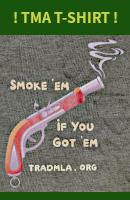Well I think the guys have pretty much covered it .
The CVA mountain rifle has about ¾ to maybe 1 inch more drop at the heal then the TC does .
IF its an original .
Today , if I recall TC and CVA both use an average 2 ½ to 2 ¾ drop at the heal . Myself I personally don’t think this fits anyone well . But it is more along the lines of center fire dimensions and this more acceptable to those who seem to want a scope mounted ..
I could be wrong as I have not seen or measured one of the mountain rifles put out by cabin creek . They say its supposed to be off of the original CVA mountain rifle stock pattern
The Mountain rifle though was CVA’s flagship . The American made model minus issues with the main springs is and was every bit as well built as anything TC has made .
The barrel should be a 1 in 66 . If its marked made in the USA it will be a Douglas or Sharon barrel .
Its worthy to not here that these barrels were extruded NOT drawn as is the standard for all companies today .. I have read where Douglas had an issue with this as did many other barrel makers during that time . Basically as I understand it the barrels would crack during the breeching .
Myself though I personally have never heard of one failing after completion and have become to be very sought after despite being made from extruded steel . So much so that in the last few year the prices of used CVA mountain rifles with barrels stamped “ MADE IN THE USA” have climbed to near or past used TC rifles . In fact I have seen them sell for more then a New Lyman.
I think this has also helped cabin creek boost its cost of the new mountain rifles somewhat .
Now why I say probably it’s a 1 in 66 .
Up untell a few months of ago I would have stood up and stated flat out that CVA never produced a barrel in any of it traditional rifles in anything but 1 in 66 . But recently I took an early CVA Kentucky in on trade . The PO stated he never could hit a can at 10 ft with the rifle . One of the reasons I snagged it was because the barrel is un marked . As I said very early CVA . Possibly a Sharon or Douglas barrel . Which as I understand it ,were also used on a very limited number of Kentucky’s during 2 very limited production runs by CVA .
The first was run was a full stock Kentucky . Second was the two piece stock and just prior to CVA switching over to Jukar contracts .
It sat out in my shop for a few months before I had a customer that wanted a revamp . When I took it down to check the rifle out , I found something very odd and told the customer I could not revamp the rifle for them . I have not measured it but it may be as fast as 1 in 12 . How that barrel got on that rifle is beyond me . Its to fast a twist for most anything . I have thought about it often am have come to the possibility that it may have been a blank that was intended for pistol stock and somehow found its way into the rifle barrel pile

?
So I would ask your friend to check the twist . I would be 99.99% sure his mountain rifle would be a 1 in 66 . But CVA did so many different things through the years , one cannot be 100% certain without checking it .
As to your stock issues ..
My honest opinion IronDawg is that you can spend a lot of time and money buying production guns . Searching for ones with a little more drop . Then what is standard today . The traditions Pennsylvania and Kentucky both have lots of drop . But the also carry the roman nose type comb . Which for me , beats my face up..
Or you can just settle for the fact that your best option is a custom stock that is cut to fit your need .
With your rotator cup issue , I would thing you would need something designed to be shot from the should not from the arm IE no croissant butt.
Also something with a large amount of drop and cast off , so as to have the sight plain center of the eye , while the neck is erect. IE not leaning forward and minimal tilting of your neck .
You simply not going to find that in any production gun
Anything that has the creissant or simi cresant butt plate and thus meant to shoot off the for arm just off the shoulder or right on the joint of the shoulder is going to cause you issues with heavier loads and especially in heavier calibers. Combine that with a short drop where you have to twist and lean . Its all going to throw more pressure right in to your rotator
The butt plate on the Mountain rifle is somewhat like what you have on your Lyman . However the distance from the heal to toe is as I recall about 1 inch less then the lyman .
Anyway , I have wrote more here then probably was needed . Hope it helps you some




